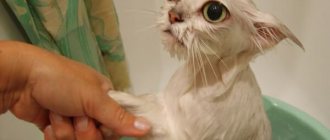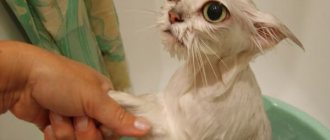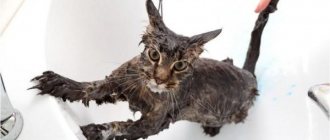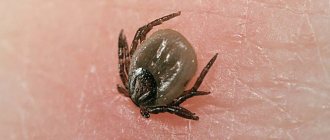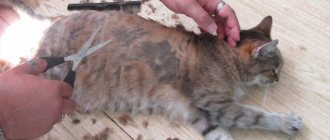Any cat owner will confirm that one of the most difficult aspects of caring for a pet is bathing it. Most cats cannot stand water, so washing your cat without scaring him or leaving him bitten and scratched is an almost impossible task. Why is this happening? Can an owner teach a cat not to be afraid of water, or bathe an animal without harm to both parties - something out of the realm of science fiction?
Why are cats afraid of water?
A cat's fear of water is a topic on which an experienced zoopsychologist is ready to discuss for hours. This fear can have so many obvious and hidden reasons (some of which are determined by the pet’s individual life experiences) that it is impossible to list them all. Most often, the root of the problem lies in factors such as:
- Unusual environment. Cats are rather conservative animals that react sharply to changing environmental conditions. If something does not allow the pet to quickly assess new circumstances (for example, due to paws sliding along the bottom of the bathtub and altered gravity, it is difficult for the animal to determine its position in space, and the transparency of the water prevents it from correctly assessing the area occupied by a “wet obstacle”), stress reaches the level of aggressive panic.
- Noise. For reasons of convenience, many owners prefer to wash their pets in the shower, while the sound of streams of water escaping from the watering can horrifies the animals. Cats are generally very nervous about noise, especially if they are unable to understand its nature. It is possible that the unfortunate pet will mistake the vibrating watering can for a living creature, hissing, spitting water and clearly in an aggressive mood. The reaction will be appropriate.
- Restriction of freedom. There is not a single cat who would calmly react to attempts to forcibly keep him in place, especially in an unpleasant environment.
- Smell. Having a keen sense of smell, cats cannot stand the “aroma” of wet fur, especially if it comes from themselves. Once faced with the problem of an unbearable odor after a bath, the pet will most likely prefer to avoid water procedures in the future.
- Overheating or hypothermia. When drawing a bath, most owners are guided by their own ideas about a comfortable water temperature. This is mistake. We must not forget that the normal body temperature of a cat differs from that of a human and is 37–39°C. Accordingly, the animal should be bathed in water heated to a pleasant 40°C, and nothing else. If your pet has previously been forced to take a bath that is too cold or too hot, he is unlikely to want to repeat this experience.
Prices for washing cats and cats
In our pet salon, services are provided both as a package and separately.
Washing a cat costs 500 rubles. But, as a rule, washing is combined with a haircut or combing. Such complexes cost from 1000 to 1400 rubles. Moreover, the cost of washing depends on the condition of the coat and the behavior of the animal.
applying anti-scratch stickers to claws, also called “soft claws,” is very popular in the salon The sticker service costs 150 rubles. or 350 rub. (if we use our own anti-scratch pads).
Prices for our other services
When should you wash your cat?
A domestic cat, unlike a human, does not need a daily shower. The animal satisfies its minimal hygiene needs by licking itself. However, it would be a mistake to believe that your pet does not need to be bathed at all. An animal cannot do without taking a bath:
- in case of visible contamination of the wool or the formation of tangles in it;
- on the recommendation of a veterinarian as part of the treatment of dermatitis and other skin diseases;
- before participating in exhibition events.
It is imperative to wash the kitten when it is brought to its new home. This is especially true if the animal is picked up on the street. If possible, you should wait 3 weeks after the move for the baby to adapt to the new conditions. Then there will be a chance that water procedures will not result in too much stress for the kitten. However, there are other ways to clean an animal’s fur.
A short plan on how to wash a cat
- Before you start “cat” water procedures, you need to understand what should be done. First of all, prepare everything you need right away so that you don’t have to rush around the bathtub looking for cat shampoo or a towel. All your movements should be clear, but not sharp, so as not to frighten the washing animal. You can lay a blanket or a large towel on the floor, which will absorb moisture, because it is unlikely that your four-legged friend will sit meekly in a basin or sink while he is soaped and water is poured on him.
- Make the bath safe for you and your cat. Remove hanging towels, as a frightened cat might grab onto them. Remove all washcloths, move the soap dishes to the far corner, and open the bottle of shampoo immediately so as not to twist it later. Close the doors, do not create drafts, so that the pet does not catch a cold.
- Be sure to buy yourself a water thermometer. It will help you not to burn or “freeze” your pet. What seems warm to you is cold to your cat, because his body temperature is several degrees higher than yours. Some people pour water directly into a basin, and then wash the cat with this water, because the pet is terribly afraid of the sound of water from the tap. Others wash in the “rain” or under the tap. But here it is worth considering that you should not get your ears and eyes wet. In addition, you should monitor the temperature of the water, because sometimes “interruptions” in the water supply are recorded: then suddenly the hot water disappears, then suddenly there is no cold water. These sudden changes can greatly frighten the animal.
- Protect yourself. A jacket with long sleeves, preferably with thick fabric. You can put folded hand towels under your sleeve to protect yourself if your cat suddenly decides to scratch or bite you. You should not punish the purr for this; being in such unusual conditions for him is stressful.
- Wet the coat thoroughly before applying shampoo. Long-haired cats take longer to get wet than short-haired or hairless cats. Otherwise, cosmetics will not be able to properly “remove” dust from under the hair scales.
- Lather gently. Make sure that the foam and the shampoo itself do not get into your eyes, nose or ears. You should also rinse off extremely carefully, but thoroughly, so that cosmetics do not remain on the fur.
- Don’t believe it if your pet suddenly, after numerous attempts to escape from you, decided to “put up with it” and became quiet. Do not lose vigilance and do not loosen your “grip”, continuing to firmly fix the purr. Otherwise, he will take the chance and run away from you.
- It is important to know not only how to wash a cat, but also how to dry it. You should not let the animal go wet, even if the house is very warm. Firstly, there is a high risk that your four-legged friend will catch a cold. Secondly, it will either lie down somewhere wet, wet everything, or even more fun - it will collect dust on itself, and you will have to rack your brain again about how to wash the cat a second time.
Dry shampoo is the way out
So, the owner decided that bathing the cat is an objective necessity, but the animal does not let itself be handled, bites, scratches and protests against water procedures in every possible way. What to do?
The way out is to use dry shampoo. Even though the effect of such a procedure is not comparable to the cleanliness after washing, treating the fur with this product gives cats less discomfort than bathing.
The powder from the bottle is applied to the animal’s fur coat directly with your hands, making massaging movements with your fingers. After this, so that the product is distributed evenly, the pet is combed. There is no need to wash off the powder with water.
It is important to take precautions when working with dry shampoo. Firstly, the procedure should be carried out in a room where the floors can be washed (it is almost impossible to remove spilled cleaning powder from the carpet without damaging the latter). Secondly, use the product no more than once every six months. Otherwise, the animal will develop an allergic reaction to the shampoo. This leads to a logical disappointing conclusion: dry cleaning products are not a panacea, and sooner or later the cat will have to be washed in the traditional way.
Principles of operation of a veterinary clinic
Emergency veterinary care in Balashikha operates 24 hours a day, seven days a week. There is no need to make an appointment with a veterinarian for this type of care. A doctor is called when the situation is critical. Animals may have several such moments:
- There is severe bleeding that cannot be stopped.
- There is an open wound and a fracture on the body.
- The animal fell from a great height, cannot get up, wheezes.
- Convulsions and epileptic seizures are visible.
- Difficult childbirth, when the female cannot give birth.
In such situations, only competent assistance from a veterinarian can save the patient’s life. The points described above are typical for cats and dogs, but exotic representatives of the fauna are often found in city apartments. Reptiles, snakes, turtles, birds, rodents - every patient requires qualified assistance. 24-hour veterinary care for unusual animals is just as prompt. Our veterinary clinic can send a ratologist, ornithologist, herpetologist and other specialists on call.
If the veterinary ambulance upon arrival discovers that the situation is fatal and cannot be dealt with at home, the patient is urgently hospitalized. Transportation takes place by the veterinary clinic, using a specially equipped vehicle. The driver transports the animal carefully and carefully. Already at the colleague’s place, doctors provide the maximum possible veterinary care.
An emergency veterinary care clinic is the key to a long life and excellent health for our beloved animals! If your pet is in trouble, call the vet immediately!
How to prepare a cat for a bath, what should you prepare?
If there is no alternative to taking a bath, and the pet is afraid to wash, the owner’s first priority is to prepare the pet for the procedure in such a way as to minimize its stress. How to do it?
First of all, you need to try to ensure that the cat starts water procedures in the most relaxed state. The best way to calm an animal is through active games. A long chase for a fishing rod or ball will help your pet let off steam, but at the same time exhaust him, depriving him of the strength to resist.
Some cats find brushing soothing. This procedure will help kill two birds with one stone. It will put your pet in a calm mood, and at the same time it will allow you to get rid of tangles in the animal’s fur, which will interfere with washing.
It is impossible to know what is going on in the animal’s head, so even if the cat seems to have calmed down and prepared for a bath, its owner should protect himself. To do this, the pet’s claws are trimmed in advance. Easily excitable and aggressive animals, just in case, are placed in a special bathing bag that restricts movement (you can buy one at any large pet store).
In addition, before bathing your cat, you should prepare in advance:
- pet shampoo that corresponds to the type of pet’s fur and the task at hand (for example, for flea treatment);
- a washcloth for applying it;
- a small ladle to make it easier to wash away soap suds by pouring water on the animal from above;
- a wide towel to completely wrap your pet in after a bath;
- a rubber cap to protect the cat’s ears from water getting inside (you can buy it at a veterinary pharmacy, pet store, or make it yourself from scrap materials).
So that the animal does not get nervous because of the sound of pouring water, it is also worth drawing a bath for it in advance. To bathe your pet, it is convenient to use a deep basin of small diameter. A special mat is laid at the bottom, which will prevent the cat's paws from slipping on the wet surface and will help the animal feel calmer and more confident.
Urgent call to the veterinarian
Pets, like people, get sick from time to time. Various infections, bruises, fractures, bleeding - all cases require the help of a professional doctor. Emergency veterinary care treats animals at home. Experts in the field of veterinary medicine and qualified staff of the clinic are ready to treat small patients around the clock. Thanks to the availability of precise and modern equipment, veterinarians are able to carry out many necessary procedures at home.
More and more owners trust emergency veterinary care specialists. There is no better option for Balashikha. The main advantages of such a service are as follows:
- The animal is almost not nervous. All pets, without exception, are very worried when visiting the clinic. New place, new smell, new scary stranger. In a state of stress, all diseases worsen, new unpleasant symptoms appear. Emergency veterinary care doctors are well aware of this feature and try to smooth out the rough edges as much as possible when visiting patients at home.
- Time is not wasted. The owner does not need to sit in line waiting to see a veterinarian. A veterinary clinic specialist will arrive at a clearly stated time around the clock.
- Wide possibilities for consultation. Veterinary care for pets provided in real conditions helps the doctor observe the patient’s life: quality of care, behavior, alarming symptoms. The recommendations obtained in this way significantly improve the animal’s standard of living.
- Veterinary care at home is inexpensive. In our clinic, the price list for services is the same, regardless of the place of provision. It is very convenient for residents of the region to call a doctor to their home, knowing that the agreed amount of money will not increase significantly.
Ordering the service is very simple, one call to the website, and the emergency veterinary doctor is already rushing in your direction. The waiting time depends on the traffic situation, but usually does not exceed 30-40 minutes. The doctor on duty will write down your coordinates and ask you about your symptoms in detail. Signs of illness will help the veterinary center employee to call the right specialist. Our clinic employs many doctors of various specialties.
It is important to us to provide emergency veterinary care in the right way. If in a conversation it is possible to establish what kind of disease the pet is suffering from, the doctor on duty will send a specialist doctor to call. In other situations, a therapist comes out.
Washing the kitten
Kittens are much easier to wash than adult cats. It is advisable to start washing kittens when they are one year old. But there are situations when you have to start washing earlier. Little kittens love to climb everywhere. They are especially occupied by the windowsill, on which your favorite flowers stand. And having tossed around in the ground to their heart’s content, they, as if nothing had happened, with dirty paws, come to your bed. Your task is not only to wash the kitten, but also to try to accustom it to water. Don't scold him, let him remain in a playful mood. After filling the basin or bathtub with water, close the water. Place one or more of your kitten's favorite toys in the water. And then quietly lower the kitten into the water. Consider yourself very lucky if the kitten does not get scared, but on the contrary, starts playing in the water. Don't bother him, let him play a little. And after some time, start washing your mischief-maker.
Try to accustom your kitten to water
How to wash a cat
Not every shampoo is suitable for washing our furry pets. And our praised shampoos will not suit them. Suitable detergents have long been invented for our cats and kittens. And they are sold, of course, in a pet store. So before you wash your cat, buy a special shampoo for him. You may also see dry shampoo at the pet store. It is created for cats that absolutely cannot be washed. I can't recommend it because it's less effective. Try to better negotiate with your cat regarding water procedures.
Choose shampoo for your cat at a pet store

